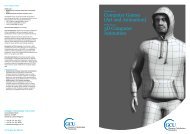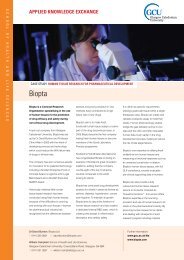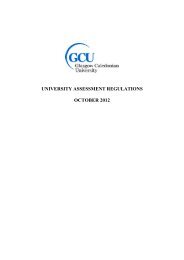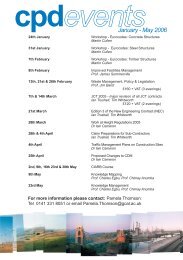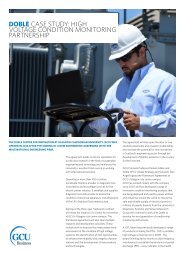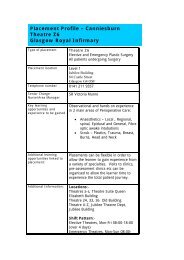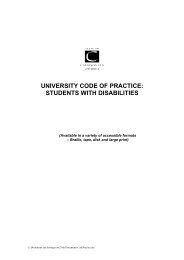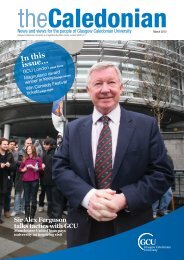Introduction - Glasgow Caledonian University
Introduction - Glasgow Caledonian University
Introduction - Glasgow Caledonian University
You also want an ePaper? Increase the reach of your titles
YUMPU automatically turns print PDFs into web optimized ePapers that Google loves.
<strong>Introduction</strong><br />
This document provides a snapshot of<br />
the research activity in the Department<br />
of Vision Sciences at <strong>Glasgow</strong><br />
<strong>Caledonian</strong> <strong>University</strong> over the period<br />
from January 2003 to December 2004.<br />
The dynamic research profile found in<br />
this document represents the<br />
culmination of considerable efforts by<br />
the Department from the inception of<br />
<strong>Glasgow</strong> <strong>Caledonian</strong> <strong>University</strong> in 1993<br />
to the present day.<br />
The quality of research within the<br />
Department of Vision Sciences has<br />
been assessed at 3 Research<br />
Assessment Exercises in 1992, 1996<br />
and 2001 and the Department has<br />
improved its research rating continually<br />
at every exercise from a 2 grade in 1992<br />
to a 4 grade in the most recent exercise<br />
in 2001.<br />
period from Jan 2001 to the end of<br />
2004.<br />
The research activity of the Department<br />
is ongoing and expanding with the<br />
strategic appointment of several<br />
research active members of staff<br />
following the success of the Department<br />
in gaining a 4 grade at the last RAE.<br />
These appointments and the continuing<br />
effort of established members of staff<br />
should place the Department in a strong<br />
position for the next RAE in 2008.<br />
Dr Lyle S Gray<br />
Senior Lecturer<br />
Postgraduate Tutor<br />
Chair, Vision Sciences Research Committee<br />
The forerunner institution (<strong>Glasgow</strong><br />
Polytechnic) of <strong>Glasgow</strong> <strong>Caledonian</strong><br />
<strong>University</strong>, had limited funding for<br />
research. At this time the Department of<br />
Vision Sciences research effort was<br />
limited in scope and produced only 2<br />
PhDs, 2 MPhils and a few refereed<br />
papers in its 20 year lifetime. In the two<br />
years covered by the current report the<br />
Department has graduated 4 PhDs, 1<br />
MPhil and published 66 papers in<br />
internationally recognised peerreviewed<br />
journals.<br />
External income generation has grown<br />
with each successive RAE submission<br />
from a very low baseline at the first RAE<br />
in 1992 to the last RAE in 2001 where<br />
the Department reported total research<br />
income of £1.4M. In the current RAE<br />
cycle, the Department has earned<br />
external income of around £1M in the
Staff in the Department of Vision<br />
Sciences<br />
Head of Department<br />
Professor Alan Tomlinson DSc , PhD, FCOptom,<br />
FAAO<br />
Assistant Head of Department<br />
Professor Gordon Heron, PhD, FCOptom, FAAO<br />
Programme Organiser (Optometry)<br />
Professors<br />
Professor Daphne McCulloch OD, PhD, FAAO<br />
Professor of Visual Electrophysiology, &<br />
Associate Dean for Research, Knowledge<br />
Transfer and Commercial Development, School<br />
of Life Sciences.<br />
Professor Michael Doughty, Professor of Ocular<br />
Pharmacology & Physiology<br />
Professor Alexander Logvinenko Professor of<br />
Professor Gordon Dutton MD, FRCOphth,<br />
Professor of Clinical Research<br />
Readers & Senior Lecturers<br />
Dr. Norman Button PhD, FCOptom.<br />
Senior Lecturer & Clinic Director<br />
Dr. Lyle Gray PhD, MCOptom.<br />
Senior Lecturer, Postgraduate Tutor & Chair of<br />
Research Committee<br />
Dr. Velitchko Manahilov PhD.<br />
Reader<br />
Dr. Gunter Loffler PhD.<br />
Mr Lex McClymont FBDO.<br />
Mr. John Mitchell, BA, FBDO.<br />
Dr Nadia Northway PhD, BEd, DBO.<br />
Dr. Katherine Oliver PhD, MCOptom.<br />
Dr. Ian Pearce PhD.<br />
Mr John Ross* FBDO.<br />
Dr. Dirk Seidel PhD.<br />
Dr Uma Shahani PhD.<br />
Postdoctoral Research Fellows<br />
Dr. Ross Henderson* PhD, MCOptom,<br />
Dr Jackie Christie* PhD.<br />
Dr KellyAnne Findlay* PhD, DBO.<br />
Dr. Tara Beattie PhD.<br />
Dr. Julie Calvert PhD.<br />
* These members of staff all left the Department<br />
during the period of this review.<br />
Dr. Harry Orbach PhD.<br />
Reader<br />
Dr. Bill Simpson PhD*.<br />
Senior Lecturer<br />
Dr. Niall Strang PhD, MCOptom.<br />
Senior Lecturer<br />
Dr. Glyn Walsh PhD, FCOptom.<br />
Senior Lecturer & Programme Organiser<br />
(Dispensing)<br />
Ms. Lesley Watson BEd, DBO.<br />
Senior Lecturer<br />
Lecturers<br />
Dr Gael Gordon PhD, MCOptom.
Research Groups<br />
Anterior Eye<br />
The anterior eye contains the main optical<br />
components of the visual system. The complex<br />
anatomical structure subserve many important<br />
physiological processes. The Anterior Eye<br />
Research Group is a well established research<br />
group with interests in the cornea, the tear film<br />
and other anterior tissues in both healthy eyes<br />
and those suffering from a range of pathological<br />
conditions. Primary research areas include:<br />
Corneal and conjunctival anatomy<br />
Corneal and conjunctival metabolism<br />
Corneal topography and sensitivity<br />
Normal and abnormal tear film<br />
physiology<br />
Physiological impact of contact lenses<br />
Clinical assessment of ophthalmic<br />
pharmaceuticals<br />
Mechanisms of corneal infection<br />
Refractive surgery and visual<br />
performance<br />
Physiological effects of ophthalmic<br />
materials<br />
Research Staff<br />
Prof Tomlinson, Prof Doughty, Dr Pearce, Dr<br />
Christie, Dr Beattie, Dr Button, Dr Oliver, Dr<br />
Walsh, Mr Mitchell.<br />
Visual Development<br />
At birth the visual system is immature.<br />
Development of the eyes, the visual pathways<br />
and cortical visual processing is dependent upon<br />
complex interactions between growth and visual<br />
experience, which are vulnerable to disruption<br />
during the early developmental period. Current<br />
research topic are:<br />
Visual development in premature infants<br />
Impact of maternal lipid nutrition on<br />
visual development<br />
Electrophysiological assessment in<br />
children with neurological impairment<br />
Visual function in children with optic<br />
nerve hypoplasia and phenylketonuria<br />
Maturation of magnocellular and<br />
parvocellular pathways<br />
Physiological correlates of face<br />
perception in children<br />
Spatial and temporal visual processing<br />
in the infant visual system.<br />
Cognitive visual dysfunction in children<br />
Research Staff:<br />
Prof McCulloch, Prof Dutton, Dr Manahilov, Dr<br />
Shahani, Dr Gray<br />
Oculomotor Function<br />
Clear, single vision depends upon coordinated,<br />
accurate binocular vision responses in the visual<br />
system. These responses are produced by a<br />
complex neuromuscular system in each eye,<br />
and disruption to these processes may be the<br />
precursor to the development of anomalies such<br />
as myopia and amblyopia. Current research<br />
topic include:<br />
The effect of ageing upon oculomotor<br />
function<br />
The impact of virtual reality display<br />
technology upon oculomotor function<br />
The role of oculomotor function in the<br />
onset and development of myopia<br />
Oculomotor dysfunction and eye<br />
movements in amblyopia and myopia.<br />
Eye movements in premature and fullterm<br />
infants<br />
The Oculomotor Function Research Group is<br />
internationally recognised and currently has<br />
ongoing collaborations with groups in <strong>University</strong><br />
of California (Berkeley), USA and Queensland<br />
<strong>University</strong> of Technology, Australia. The group<br />
has produced significant research outputs for<br />
the past 10 years, publishing a substantial<br />
number of papers in internationally recognised<br />
peer reviewed journals, and producing<br />
significant numbers of PhD and MPhil awards.<br />
External funding has been obtained to support<br />
the activities of the group including a number of<br />
recent postgraduate studentships.<br />
Research Staff<br />
Professor Heron, Dr Gray, Dr Strang, Dr Seidel,<br />
Mr Stanger, Dr Northway, Prof Tomlinson, Prof<br />
Doughty<br />
Visual Psychophysics<br />
Visual psychophysics is the quantification of<br />
visual perception and explores the complex<br />
interaction between the eyes and the brain. This<br />
field has many practical applications to visual<br />
tasks such as driving, reading and visual search.<br />
The Visual Psychophysics Research Group has<br />
a well established international profile. Current<br />
research topics include:
Motion perception<br />
Pattern recognition<br />
Image processing<br />
Visual functions and testing in eye<br />
diseases<br />
fMRI studies of visual perception<br />
Face/shape perception<br />
Clinical instrumentation in eye disease<br />
and the developing visual system<br />
Impact of optical correction on visual<br />
function<br />
Research Staff<br />
Prof Logvinenko, Dr V Manahilov, Dr Orbach, Dr<br />
Loffler, Dr Strang, Dr Gray, Prof Doughty
Research related<br />
activity in the<br />
Department of Vision<br />
Sciences<br />
The work of research active<br />
staff within the Department of<br />
Vision Sciences is<br />
recognised both nationally<br />
and internationally.<br />
Reviewing for peerreviewed<br />
journals<br />
Research active staff in the<br />
Department undertake peer<br />
reviewing duties for many<br />
national and international<br />
journals. These journals have<br />
some of the highest impact<br />
factors found within the<br />
discipline.<br />
British Journal of<br />
Ophthalmology<br />
Clinical & experimental<br />
Optometry<br />
Clinical & Experimental<br />
Ophthalmology<br />
Contact Lens & Anterior<br />
Eye<br />
Current Eye Research<br />
Experimental Eye<br />
Research<br />
Eye<br />
Eye & Contact Lens<br />
GMC Ophthalmology<br />
Investigative<br />
Ophthalmology &<br />
Visual Science<br />
Journal of the Optical<br />
Society of America<br />
Journal of Physiology<br />
Journal of Vision<br />
Ophthalmic &<br />
Physiological Optics<br />
Ophthalmology<br />
Optometry & Vision<br />
Science<br />
Perception<br />
Vision Research<br />
Visual Cognition<br />
Von Graefes’ Archives<br />
of Ophthalmology<br />
Reviewing for External<br />
Funding Bodies<br />
Research active staff are<br />
often invited to undertake<br />
reviewing duties for many of<br />
the external grant awarding<br />
bodies, both in the UK and<br />
internationally.<br />
Engineering & Physical<br />
Sciences Research<br />
Council<br />
Biomedical &<br />
Biotechnology Sciences<br />
Research Council<br />
National Health Service<br />
– Health Technology<br />
Assessment<br />
Programme<br />
Chief Scientists Office<br />
Israel National<br />
Academy of Sciences<br />
US Department of<br />
Veterans Affairs<br />
There must be others – can<br />
people please supply info<br />
Collaborative<br />
Research Activity<br />
Research active staff in the<br />
Department undertake much<br />
collaborative work with<br />
researchers both nationally &<br />
internationally<br />
Dr Michael Collins,<br />
Queensland <strong>University</strong><br />
of Technology,<br />
Australia<br />
Professor Clifton Schor,<br />
<strong>University</strong> of Berkeley,<br />
USA<br />
Professor Neil<br />
Charman, <strong>University</strong> of<br />
Manchester, UK<br />
Professor David<br />
Atchison, Queensland<br />
<strong>University</strong> of<br />
Technology, Australia<br />
Professor Hugh Wilson,<br />
York <strong>University</strong>,<br />
Canada<br />
Dr Ed Chronicle,<br />
<strong>University</strong> of Lancaster,<br />
UK<br />
Dr Anita Simmers, City<br />
<strong>University</strong>, UK<br />
Dr William Simpson,<br />
DRDC Toronto,<br />
Canada<br />
Professor Angel<br />
Vassilev, Bulgarian<br />
Academy of Sciences,<br />
Bulgaria<br />
Prof. David Popivanov,<br />
Bulgarian Academy of<br />
Sciences, Bulgaria<br />
Professor L Maloney,<br />
New York <strong>University</strong>,<br />
USA<br />
Dr Mark Borchert,<br />
Childrens Hospital, Los<br />
Angeles, USA<br />
Professor Vengu<br />
Lakshminarayanan,<br />
<strong>University</strong> of St. Louis,<br />
USA<br />
European PKU LC<br />
PUFA Supplementation<br />
Trial, Multicentre<br />
Dr Lena Jacobson,<br />
Tomtoboda Institute,<br />
Sweden<br />
Professor Jan<br />
Bergmanson, <strong>University</strong><br />
of Houston, USA<br />
Dr Paul Murphy,<br />
UWCC, UK<br />
Professor Graeme<br />
Wilson, Indiana<br />
<strong>University</strong>, USA<br />
Professor Michael<br />
Bach, Freiburg<br />
<strong>University</strong>, Germany
Externally funded<br />
research in the<br />
Department of Vision<br />
Sciences in 2003 and<br />
2004<br />
Principal investigators:<br />
Dr Bill Simpson<br />
Dr Velitchko Manahilov<br />
Efficiency of human<br />
suprathreshold visual<br />
detection<br />
Funding body: EPSRC<br />
Total award: £56,135<br />
We developed and tested<br />
novel methods for estimating<br />
internal noise and sampling<br />
efficiency of suprathreshold<br />
vision. The essence of these<br />
models is the assumption<br />
that the response variability is<br />
a measure of performance<br />
efficiency of suprathreshold<br />
vision. We have found that<br />
the additive internal noise are<br />
comparable with results<br />
obtained in detection of<br />
threshold patterns, while the<br />
estimated sampling efficiency<br />
in a reaction time task is<br />
much lower than that<br />
obtained in threshold<br />
experiments. These results<br />
suggest that a large part of<br />
the variability in reaction<br />
times arises from the motor<br />
system rather than the visual<br />
system. We developed an<br />
elaborated model for<br />
estimation of arrival time of a<br />
visual signal which allows<br />
measuring sampling<br />
efficiency and additive<br />
internal noise as well as<br />
multiplicative components of<br />
induced internal noise due to<br />
the visual signal and external<br />
visual noise. Using a soundpattern<br />
simultaneity<br />
judgement paradigm, we<br />
found that abovethreshold<br />
Gabor patches of low spatial<br />
frequency are detected with<br />
higher sampling efficiency<br />
than Gabor patches of higher<br />
spatial frequency. These<br />
findings provide new<br />
information about the sources<br />
of human inefficiency in<br />
processing suprathreshold<br />
visual patterns.<br />
Principal investigator:<br />
Dr Error! Contact not<br />
defined.<br />
The development of a<br />
systematic test protocol for<br />
identifying functional visual<br />
losses in amblyopia<br />
Amblyopia is a condition in<br />
which the best corrected<br />
visual acuity is reduced in the<br />
absence of detectable<br />
anomalies of the visual<br />
pathway. It is believed to be<br />
treatable provided that the<br />
appropriate refractive<br />
correction and therapy is<br />
administered at as early an<br />
age as possible.<br />
Recent evidence has<br />
identified four major types of<br />
underlying visual deficit in<br />
amblyopia: Abnormal contour<br />
interaction, abnormal contrast<br />
perception, abnormal eye<br />
movements and positional<br />
uncertainty. These visual<br />
deficits can be rapidly<br />
assessed in amblyopic<br />
children using a simple<br />
battery of chart based tests:<br />
Single letter acuity, high<br />
contrast linear letter acuity,<br />
low contrast linear letter<br />
acuity, repeat letter acuity,<br />
and hyperacuity.<br />
Currently only high contrast<br />
visual acuity is measured, but<br />
in many amblyopic children<br />
the primary visual deficit does<br />
not lie in the high contrast<br />
visual acuity domain. Often<br />
the most reduced functional<br />
deficit is the one which shows<br />
the best improvement during<br />
treatment. It is therefore<br />
important to identify all the<br />
functional deficits and<br />
monitor all these during<br />
therapy. The main reason<br />
that these functional deficits<br />
are not assessed clinically is<br />
because there is no<br />
standardised clinical testing<br />
protocol which can be<br />
applied.<br />
The aim of this PhD project is<br />
to develop a standardised<br />
testing regimen using<br />
knowledge gained from<br />
previous studies in childhood<br />
amblyopia and from own<br />
research.<br />
Funding body: College of<br />
Optometrists<br />
Total award: £44,250<br />
Principal investigator:<br />
Dr Gunter Loffler<br />
The perception of shapes in<br />
motion<br />
Funding body: EPSRC<br />
Total award: £126,470<br />
From the birth of the<br />
perceptual sciences,<br />
researchers have been<br />
interested in the remarkable<br />
ability of the human visual<br />
system to extract an accurate<br />
picture of the world from the<br />
light array falling on the<br />
retina. For the most part<br />
work has concentrated on<br />
static objects, thus neglecting<br />
a crucial factor: we live in a<br />
dynamic environment.<br />
Surprisingly, little work has<br />
been done on the<br />
discriminability of shapes<br />
when they are in motion. It is<br />
not obvious that data from<br />
static experiments allow<br />
useful extrapolations to be<br />
made, which can predict<br />
performance under dynamic<br />
conditions.<br />
The proposed research<br />
will address this gap and the
esults are expected to<br />
contribute to our<br />
understanding of human<br />
visual perception in a novel<br />
and important direction.<br />
Psychophysical experiments<br />
and computer simulations<br />
form the backbone of this<br />
proposal. The former will<br />
allow the quantitative<br />
comparison of performance<br />
in static and dynamic<br />
environments and, in<br />
combination with the latter,<br />
provide insight into<br />
underlying computations.<br />
Principal Investigators:<br />
Professor Alan Tomlinson<br />
Dr Ian Pearce<br />
Effect of chronic application<br />
of a water emulsion on<br />
mild/moderate dry eye<br />
Funding body: Allergan<br />
Total award: £30,900<br />
The study undertakes an<br />
evaluation of the long term<br />
effects on tear physiology of<br />
the oil water emulsion<br />
available now as the Refresh<br />
Endura eyedrop from<br />
Allergan by evaluating its<br />
effects on mild/moderate and<br />
severe dry eye patients<br />
against a<br />
hydroxypropylmethyl<br />
cellulose (HPMC) based<br />
product on tear physiology.<br />
The benefits of the eyedrops<br />
will be assessed by a range<br />
of objective techniques,<br />
including fluorescein break<br />
up time (TBUT), tear film<br />
evaporation rate (TER), tear<br />
film structure by dynamic thin<br />
film interferometry (TFI), tear<br />
turnover rate (TTR) by<br />
automated scanning for<br />
fluorophotometry, tear<br />
osmolality by the Clifton<br />
freezing point depression<br />
technique and symptoms by<br />
the OSDI dry eye<br />
questionnaire. Full<br />
assessment of tear<br />
physiology will be carried out<br />
at baseline and 30 and 90<br />
days following the<br />
prescription of the tear<br />
supplement.<br />
Principal investigator:<br />
Dr Ian Pearce<br />
Investigation of a novel dry<br />
eye therapy<br />
Funding body: Sequani<br />
Consumer<br />
Total award: £64,780<br />
Principal Investigator:<br />
Professor Alan Tomlinson<br />
Dry eye in cataract surgery<br />
Funding body: Allergan<br />
Total award: £15,000<br />
The tears act as a protective<br />
and nurturing medium for the<br />
exposed anterior ocular<br />
tissues. Any adverse<br />
changes in the tear film may<br />
lead to dry eye. There are<br />
various conditions that have<br />
been shown to be a<br />
causative factor of dry eye.<br />
Previous tests have shown<br />
that dry eye patients have<br />
less favourable outcomes<br />
from cataract surgery. There<br />
are not many studies that<br />
have tried to compare the<br />
changes in tear physiology<br />
after cataract surgery. Some<br />
studies comparing the tear<br />
physiology after other<br />
surgical procedures including<br />
PRK, LASIK involving the<br />
cornea indicate that there is<br />
an increase in dryness. The<br />
study proposes to identify the<br />
gradual changes in tear film<br />
physiology and corneal<br />
sensitivity after cataract<br />
surgery. This will contribute<br />
to the understanding of the<br />
changes in the tear film<br />
physiology and corneal<br />
sensitivity after cataract<br />
surgery, which will aid the<br />
practitioners involved in postcataract<br />
surgery<br />
management make timely<br />
judgements about potential<br />
dry eye complaints of the<br />
patients.<br />
Principal investigator:<br />
Professor Daphne<br />
McCulloch<br />
Maturation of the cone<br />
systems of the human retina<br />
Funding body: Visual<br />
Research Trust<br />
Total award: £22,500<br />
In light adapted conditions,<br />
electrical signals generated<br />
by the retina – the photopic<br />
electroretinogram (ERG) –<br />
provide a measure of cone<br />
function, from the awave<br />
component, and of postreceptoral<br />
processing from<br />
the bwave component.<br />
Five pilot studies determined<br />
ideal conditions for<br />
investigating the photopic<br />
ERG.<br />
1. Stimulus luminance<br />
2. Background<br />
brightness<br />
3. Coloured stimuli<br />
4. Flickering stimuli<br />
5. Electrode types<br />
In these studies we<br />
investigated the luminance<br />
response functions for each<br />
component of the photopic<br />
ERG. An equation was<br />
modelled to allow<br />
comparisons among subjects<br />
for the bwave component.<br />
We tested healthy adults,<br />
children and babies to<br />
establish normative data. In<br />
collaboration with the<br />
Children’s Hospital Los<br />
Angeles, our protocols were<br />
used on a cohort of children<br />
with optic nerve hypoplasia<br />
(ONH). Initial analysis<br />
suggests that, contrary to<br />
current thinking, ONH is not<br />
only an isolated
underdevelopment of the<br />
optic nerve but also<br />
demonstrates some lack of<br />
function of postreceptoral<br />
processing.<br />
Principal investigator:<br />
Professor Gordon Dutton<br />
Assessment of contrast<br />
sensitivity in infants and<br />
children with neurological<br />
impairment<br />
Funding body: Chief<br />
Scientists Office<br />
Total award: £105,938<br />
Infants and children with<br />
disabilities often cannot<br />
communicate sufficiently to<br />
allow assessment of their<br />
contrast sensitivity. The aim<br />
of this work is to develop a<br />
standardised and rapid<br />
method of measuring<br />
objectively the contrast<br />
sensitivity using visually<br />
evoked potentials. The<br />
importance of this work lies in<br />
the design of educational<br />
materials for these children<br />
which can be easily seen.<br />
Principal Investigator:<br />
Professor Alexander<br />
Logvinenko<br />
Colour mechanisms in<br />
human vision<br />
Funding body: Wellcome<br />
Trust<br />
Total award: £114,275<br />
There is growing body of<br />
evidence that the classical<br />
theory of colour vision<br />
originally developed by D.<br />
Jameson & L. Hurvich in the<br />
1950's, and then further<br />
elaborated by L. Guth, R. De<br />
Valoise & K. De Valoise and<br />
others, is in apparent<br />
disagreement with the recent<br />
experimental data. We plan<br />
to evaluate the spectral,<br />
spatial and temporal<br />
characteristics of the yellow<br />
and blue mechanisms<br />
separately. We shall test a<br />
hypothesis that the additive<br />
conjoint structure is met for<br />
the unique yellow and blue<br />
hues. If this is the case, then<br />
an additive numerical<br />
representation will be<br />
constructed for the yellow<br />
and blue mechanisms. As a<br />
result, a nonlinear model of<br />
the yellow and blue<br />
mechanisms will be<br />
developed which will be<br />
suggested to replace the<br />
classical model.<br />
Principal investigator:<br />
Professor Alexander<br />
Logvinenko<br />
Geometrical manifold of<br />
achromatic colours of objects<br />
under natural illuminations<br />
Funding body: EPSRC<br />
Total award: £162,791<br />
A lot of effort has been made<br />
by psychologists and<br />
neuroscientists to ascertain<br />
why "things look like they do".<br />
Much less attention has been<br />
paid to establishing what<br />
exactly things look like,<br />
probably because it seems<br />
selfevident. However even<br />
such elementary perceptions<br />
as achromatic colours have a<br />
more complicated internal<br />
structure than one might<br />
suppose. Contrary to the<br />
general belief that achromatic<br />
colours can be described as<br />
a onedimensional continuum<br />
(referred to as lightness), we<br />
show that, in fact, they<br />
constitute a twodimensional<br />
manifold. We plan to study<br />
the geometrical properties of<br />
this manifold using<br />
multidimensional scaling. We<br />
shall investigate apparent<br />
illumination/lightness<br />
invariance using a new<br />
approach. We shall also<br />
address the classical problem<br />
of lightness constancy (with<br />
respect to illumination and<br />
position) within a new<br />
theoretical and<br />
methodological framework.<br />
Principal investigator:<br />
Professor Michael Doughty<br />
Comparisons of the acute<br />
effects of comfort eyedrops<br />
on human subjects<br />
Funding body: The<br />
Mentholatum Company<br />
Total award: £10,500<br />
Individuals suffering from<br />
mild ocular discomfort often<br />
will benefit from the use of<br />
some form of tear film<br />
replacement. Some of these<br />
are called comfort drops and<br />
the studies undertaken<br />
represent ongoing<br />
assessments of their effects<br />
in the eye. These<br />
assessments include detailed<br />
evaluation of the ocular<br />
surface, tear film stability and<br />
patient comfort after the use<br />
of such products.
Higher Degree<br />
Projects currently<br />
being undertaken in<br />
the Department of<br />
Vision Sciences<br />
David Bennett<br />
Spatial confusion in<br />
periventricular white matter<br />
damage<br />
Director of Studies: Professor<br />
Gordon Dutton<br />
This research is interested in<br />
the spatial vision of children<br />
with cerebral white matter<br />
damage. We are especially<br />
interested in how this<br />
damage appears to mimic a<br />
variant of Bálint’s syndrome,<br />
a loose triad of<br />
simultanagnosia (the inability<br />
to perceive multiple stimuli),<br />
gaze apraxia (the inability to<br />
control fixational eye<br />
movements) and visuomotor<br />
ataxia (an inability to make<br />
visually guided movement).<br />
This area has only recently<br />
drawn interest from the<br />
academic community and as<br />
such there is wide scope for<br />
ongoing research. In<br />
particular our aim is to<br />
develop a clinical test for the<br />
simultanagnosia aspect of<br />
this condition. This test must<br />
be able to be used on<br />
patients with a wide range of<br />
ages and disabilities. Such a<br />
test would enable better<br />
clinical management of this<br />
increasingly common<br />
condition, as well as giving<br />
insight to normal vision<br />
processes and enabling<br />
further research in this area<br />
to be carried out more<br />
efficiently.<br />
Mhairi Day<br />
The effect of stimulus<br />
characteristics on the<br />
accommodation response in<br />
myopia<br />
Director of Studies: Dr Niall<br />
Strang<br />
This project investigates the<br />
effect of target vergence,<br />
target luminance, spatial<br />
frequency content, spatial<br />
frequency adaptation and<br />
stimulus blur on the<br />
accommodation response.<br />
Both static (e.g. stimulusresponse<br />
and<br />
accommodation<br />
microfluctuations) and<br />
dynamic (e.g. steps) aspects<br />
of the accommodation<br />
response will be measured in<br />
both emmetropic and myopic<br />
subjects. Examining the<br />
effect of these factors on the<br />
accommodation response will<br />
enable us to gain a better<br />
understanding of the<br />
conditions that lead to<br />
inaccuracies in the<br />
accommodation control<br />
system. In addition, the<br />
project will examine<br />
differences in the<br />
accommodation response<br />
characteristics of myopic<br />
eyes in an effort to determine<br />
the factors that lead to the<br />
development and progression<br />
of myopia.<br />
Anneli Demberg<br />
Development of a systematic<br />
test protocol for identifying<br />
functional visual losses in<br />
childhood amblyopia and<br />
monitoring treatment efficacy<br />
Director of Studies: Dr Lyle<br />
Gray<br />
Amblyopia is a condition in<br />
which the best corrected<br />
visual acuity is reduced in the<br />
absence of detectable<br />
anomalies of the visual<br />
pathway. It is believed to be<br />
treatable provided that the<br />
appropriate refractive<br />
correction and therapy is<br />
administered at as early an<br />
age as possible.<br />
Recent evidence has<br />
identified four major types of<br />
underlying visual deficit in<br />
amblyopia: Abnormal contour<br />
interaction, abnormal contrast<br />
perception, abnormal eye<br />
movements and positional<br />
uncertainty. These visual<br />
deficits can be rapidly<br />
assessed in amblyopic<br />
children using a simple<br />
battery of chart based tests:<br />
Single letter acuity, high<br />
contrast linear letter acuity,<br />
low contrast linear letter<br />
acuity, repeat letter acuity,<br />
and hyperacuity.<br />
Currently only high contrast<br />
visual acuity is measured, but<br />
in many amblyopic children<br />
the primary visual deficit does<br />
not lie in the high contrast<br />
visual acuity domain. Often<br />
the most reduced functional<br />
deficit is the one which shows<br />
the best improvement during<br />
treatment. It is therefore<br />
important to identify all the<br />
functional deficits and<br />
monitor all these during<br />
therapy. The main reason<br />
that these functional deficits<br />
are not assessed clinically is<br />
because there is no<br />
standardised clinical testing<br />
protocol which can be<br />
applied.<br />
The aim of this PhD project is<br />
to develop a standardised<br />
testing regimen using<br />
knowledge gained from<br />
previous studies in childhood<br />
amblyopia and from own<br />
research.<br />
Helle Falkenberg<br />
An ideal observer approach<br />
to the development of motion<br />
perception in normal and<br />
abnormal vision<br />
Director of Studies : Dr<br />
William Simpson<br />
This project aims to<br />
characterise the development
of motion perception in<br />
children and subsequently<br />
determine the degree and<br />
nature of impaired motion<br />
perception in a group of<br />
children with brain damage.<br />
Sven Jonuscheit<br />
The evaluation of the cornea<br />
in myopic eyes<br />
Director of Studies: Professor<br />
Michael Doughty<br />
The main goal of this<br />
research will be to assess the<br />
cornea of myopic eyes, with<br />
special attention paid to<br />
possible differences between<br />
eyes with different degrees of<br />
myopia. The outcome<br />
measurements will include<br />
data on corneal thickness<br />
and anterior and posterior<br />
corneal curvature radius. All<br />
measurements will be taken<br />
in the centre, the midperiphery<br />
and the periphery.<br />
Detailed analyses will be<br />
undertaken to assess<br />
whether correlations can be<br />
made the cornea thickness,<br />
shape and curvature (of both<br />
surfaces) and both axial<br />
length and refractive error.<br />
Corneal curvature and<br />
thickness profile maps will<br />
also be produced. One key<br />
feature of my work will be,<br />
that the subjects will be<br />
strictly grouped according to<br />
refractive error and gender, in<br />
order to allow a weighted<br />
statistical analysis. Some<br />
emmetropic and hyperopic<br />
subjects will be included for<br />
comparison.<br />
Graeme Kennedy<br />
Static and Dynamic Aspects<br />
of Angle Perception<br />
Director of Studies: Gunter<br />
Loffler<br />
The accurate computation of<br />
object shape is a<br />
fundamental task for the<br />
visual system. The aim of<br />
this study is to investigate<br />
shape perception at a<br />
relatively low level of<br />
complexity, by measuring<br />
perception of geometric<br />
angles. A first set of<br />
experiments has shown that<br />
angle discrimination is<br />
strongly dependent on the<br />
overall stimulus shape but<br />
independent of the<br />
orientation and position of the<br />
object of which the angle<br />
forms a part. Most studies of<br />
shape perception have<br />
investigated objects that are<br />
stationary, and do not reflect<br />
the dynamic environment in<br />
which we live. The question<br />
arises as to whether results<br />
obtained with static angles<br />
can predict our perception of<br />
angles that are moving. A<br />
second set of experiments<br />
showed that angle<br />
discrimination is equally good<br />
whether the objects<br />
containing the angles are<br />
static or moving at moderate<br />
speeds. These results have<br />
strong implications for<br />
mechanisms underlying<br />
angle computation. In the<br />
final part of the study, a<br />
model for angle<br />
discrimination will be<br />
constructed using the<br />
experimental data, and<br />
predictions made by this<br />
model will be tested<br />
experimentally.<br />
Santosh Khanal<br />
Tear physiology in dry eye<br />
Director of Studies: Professor<br />
Alan Tomlinson<br />
This project includes<br />
investigations of cataract, an<br />
ocular intervention, as a<br />
cause of dry eye, severity of<br />
dry eye due to different<br />
aetiologies and the most<br />
effective management for dry<br />
eye. It is expected that the<br />
outcome of these projects will<br />
help in increasing the<br />
understanding and the<br />
management options for dry<br />
eye. I’m also working on the<br />
development of a novel noninvasive<br />
technique for the<br />
determination of thickness of<br />
the lipid layer of the tear film.<br />
The studies are being done in<br />
collaboration with various eye<br />
departments around<br />
<strong>Glasgow</strong>.<br />
Caroline Chaplin<br />
Maturation of the cone<br />
systems of the human retina<br />
Director of Studies: Professor<br />
Daphne McCulloch<br />
In light adapted conditions,<br />
electrical signals generated<br />
by the retina – the photopic<br />
electroretinogram (ERG) –<br />
provide a measure of cone<br />
function, from the awave<br />
component, and of postreceptoral<br />
processing from<br />
the bwave component.<br />
Five pilot studies determined<br />
ideal conditions for<br />
investigating the photopic<br />
ERG.<br />
6. Stimulus luminance<br />
7. Background<br />
brightness<br />
8. Coloured stimuli<br />
9. Flickering stimuli<br />
10. Electrode types<br />
In these studies we<br />
investigated the luminance<br />
response functions for each<br />
component of the photopic<br />
ERG. An equation was<br />
modelled to allow<br />
comparisons among subjects<br />
for the bwave component.<br />
We tested healthy adults,<br />
children and babies to<br />
establish normative data. In<br />
collaboration with the<br />
Children’s Hospital Los<br />
Angeles, our protocols were
used on a cohort of children<br />
with optic nerve hypoplasia<br />
(ONH). Initial analysis<br />
suggests that, contrary to<br />
current thinking, ONH is not<br />
only an isolated<br />
underdevelopment of the<br />
optic nerve but also<br />
demonstrates some lack of<br />
function of postreceptoral<br />
processing.<br />
Petar Mihaylov<br />
Investigation of visual<br />
function in real and artificial<br />
scotomas<br />
Director of Studies: Dr<br />
Velitchko Manahilov<br />
We base our knowledge<br />
about the external world on<br />
the perceptual representation<br />
of five senses in our brain.<br />
Vision plays an enormous<br />
role in this process. The<br />
traditional view is that there is<br />
a close correspondence<br />
between the perceived<br />
brightness distribution of a<br />
visual object and the<br />
activities of a particular set of<br />
neurones. Nowadays this<br />
view is challenged by studies<br />
on the perception of visual<br />
information within areas that<br />
have not received stimulation<br />
but are surrounded by<br />
stimulated areas (artificial<br />
scotomas). Such perceptions<br />
involve long distances<br />
interactions. In this project,<br />
we employ psychophysical<br />
and electrophysiological<br />
methods to investigate how<br />
different types of information<br />
(pattern, motion, illusory<br />
contours, noise and colour)<br />
transfer into real and artificial<br />
scotomas from surrounding<br />
stimulated areas. The results<br />
will provide information about<br />
the visual processes<br />
underlying longdistance<br />
interactions within the visual<br />
network.<br />
Taher Naase<br />
Ocular surface<br />
characteristics, sensitivity<br />
and spontaneous eye blink<br />
activity in humans<br />
Director of Studies: Professor<br />
Michael Doughty<br />
The goal of the present<br />
studies is to attempt to<br />
objectively interrelate the<br />
characteristics of the human<br />
ocular surface with the<br />
spontaneous eye blink<br />
activity. Rather than simply<br />
studying one group of<br />
individuals that might not be<br />
representative, two different<br />
groups have been<br />
deliberately recruited to<br />
compare data between these<br />
two groups of individuals as<br />
they expected to have rather<br />
different ocular surface<br />
characteristics because of<br />
their ethnic origin and the<br />
environment in their original<br />
country of residence, namely<br />
those of Arabic origin and<br />
those of white (European)<br />
origin. Various techniques<br />
have been used to evaluate<br />
the ocular surface including<br />
ocular surface contact<br />
sensitivity (CochetBonet)<br />
measures, assessment of<br />
tear film stability (with<br />
fluorescein), assessment of<br />
the tarsal conjunctival<br />
staining patterns with<br />
fluorescein (using a new<br />
automated image analysis<br />
technique), subjective and<br />
objective assessment of the<br />
staining characteristics of the<br />
eyelid marginal zone with<br />
lissamine green, and an<br />
impression cytology of bulbar<br />
conjunctival epithelium. Part<br />
of the thesis work has also<br />
been to further develop<br />
methods that can be used to<br />
record eyeblink activity (using<br />
a digital video system) and<br />
analyse it (using a more<br />
direct download of the data to<br />
a computer).<br />
David Nicol<br />
Visual evoked potentials in<br />
amblyopic and control<br />
subjects from stereoscopic,<br />
flicker and motion stimuli in<br />
humans<br />
Director of Studies: Professor<br />
Daphne McCulloch<br />
Amblyopia is characterised<br />
by deficits in stereoacuity,
spatial resolution and<br />
localisation while temporal<br />
resolution may remain largely<br />
unaffected. The aims of this<br />
PhD research project are to<br />
investigate Visual Evoked<br />
Potentials (VEPs) in<br />
amblyopic individuals using<br />
stereoscopic stimuli<br />
(anaglyphic randomdot<br />
stereograms) and to<br />
investigate the maturation<br />
process of the stereoscopic<br />
VEP in subjects with full<br />
stereopsis. The effect of<br />
amblyopia on temporal<br />
resolution is being<br />
investigated by recording<br />
VEPs to monocular and<br />
binocular luminance<br />
modulation across a range of<br />
temporal frequencies for<br />
comparison in amblyopic and<br />
control subjects.<br />
Stewart Stanger<br />
The effect of virtual reality<br />
displays upon ocular motor<br />
function and the implications<br />
for optometric practice.<br />
Director of Studies: Dr Lyle<br />
Gray<br />
Virtual Reality (VR) systems<br />
are currently used in the<br />
fields of medicine, education<br />
and engineering. The<br />
increasing affordability of<br />
computer and video games<br />
systems with substantial<br />
processing power suggests<br />
that significant public<br />
exposure to these<br />
technologies can only<br />
increase. The visual<br />
demands of VR systems are<br />
typically i) a fixed level of<br />
accommodative demand and<br />
ii) widely varying disparity<br />
vergence stimulation. The<br />
incorporation of disparity<br />
information in VR displays<br />
introduces a strong<br />
perceptual depth stimulus for<br />
the user but is highly<br />
unnatural stimulation for the<br />
binocular visual system.<br />
Numerous symptoms have<br />
been identified following VR<br />
immersion including blur,<br />
double vision, postural<br />
instability and cybersickness<br />
(similar to motion sickness),<br />
the visual symptoms may be<br />
indicative of binocular vision<br />
dysfunction following VR use.<br />
The aim of the project is to<br />
investigate systematically the<br />
effects of VR upon the<br />
binocular visual system.<br />
Janice Waterson Wilson<br />
The effect of various<br />
treatment modalities on<br />
ocular motility<br />
Director of Studies: Professor<br />
Gordon Heron<br />
The above named study<br />
encompasses patients<br />
treated through surgery,<br />
exercises, medication or<br />
optical treatment. Saccades<br />
and vergence eye<br />
movements have been<br />
investigated both qualitatively<br />
and quantitatively.<br />
Saccadic Eye Movements<br />
Group<br />
1: Retinal detachment<br />
patients, saccades recorded<br />
pre and post op, follow up for<br />
6 months<br />
2: Macular hole patients,<br />
saccades recorded pre and<br />
post op, follow up for 6<br />
months<br />
3: Strabismic patients,<br />
saccades recorded pre and<br />
post op, follow up for 6<br />
months<br />
4: Gabbapentin patients,<br />
saccades and nystagmus<br />
recorded pre and post<br />
prescription<br />
5: Normals, saccades<br />
recorded to act as a control<br />
and to assess reliability and<br />
repeatability<br />
Vergence Eye Movements<br />
Group<br />
1: Hypermetrope’s recorded<br />
with and without glasses<br />
2: Fully Accommodative<br />
Esotropes recorded with and<br />
without glasses<br />
3: Intermittent Exotropes<br />
recorded on two trials<br />
4: Normals, vergence<br />
recorded to act as a control<br />
and to assess reliability and<br />
repeatability
List of Postgraduate Awards<br />
200304<br />
Emma Price June 2003<br />
PhD<br />
Sources of variation in the clinical<br />
measurement of pulsatile ocular blood<br />
flow and their effect upon the detection<br />
of primary openangle glaucoma.<br />
Director of Studies – Dr Lyle Gray<br />
Emiljan Oblak August 2003<br />
PhD<br />
Assessment of welding ultraviolet<br />
radiation on the corneal endothelium<br />
using a newly developed computerized<br />
morphometric system.<br />
Director of Studies – Professor Michael<br />
Doughty<br />
Dirk Seidel August 2003<br />
PhD<br />
Retinotopic and spatiotopic<br />
accommodation responses in<br />
emmetropia and myopia.<br />
Director of Studies – Professor Gordon<br />
Heron<br />
Hugh Campbell March 2004<br />
MPhil<br />
The effects of alcohol dependency upon<br />
visual function.<br />
Director of Studies – Professor Gordon<br />
Heron<br />
Nadia Northway March 2004<br />
PhD<br />
Psychophysical and ocular motor<br />
aspects of visual processing in dyslexics<br />
with MearesIrlen Syndrome.<br />
Director of Studies – Dr Velitchko Manahilov
Refereed Publications<br />
Aakre, B.M., Doughty, M.J., Dalane, O.V., Berg,<br />
A., Aamodt, O., & Gangstad, H. (2003).<br />
Assessment of reproducibility of measures of<br />
intraocular pressure and central corneal<br />
thickness in young white adults over a 16h time<br />
period. Ophthalmic Physiol Opt, 23 (3), 271283.<br />
Aakre, B.M., Ystenaes, A.E., Doughty, M.J.,<br />
Austrheim, O., Westerfjell, B., & Lie, M.T.<br />
(2004). A 6month followup of successful refits<br />
from daily disposable soft contact lenses to<br />
continuous wear of highDk siliconehydrogel<br />
lenses. Ophthalmic Physiol Opt, 24 (2), 130141.<br />
Atchison, D.A., Strang, N.C., & Stark, L.R.<br />
(2004). Dynamic accommodation responses to<br />
stationary colored targets. Optom Vis Sci, 81 (9),<br />
699711.<br />
Bamashmus, M.A., Matlhaga, B., & Dutton,<br />
G.N. (2004). Causes of blindness and visual<br />
impairment in the West of Scotland. Eye, 18 (3),<br />
257261.<br />
Bambridge, A. (2004). Healing vision without<br />
spectacles, contact lenses or refractive surgery:<br />
a personal journey of healing vision. J Altern<br />
Complement Med, 10 (4), 607609.<br />
Beattie, T.K., Seal, D.V., Tomlinson, A.,<br />
McFadyen, A.K., & Grimason, A.M. (2003).<br />
Determination of amoebicidal activities of<br />
multipurpose contact lens solutions by using a<br />
most probable number enumeration technique. J<br />
Clin Microbiol, 41 (7), 29923000.<br />
Beattie, T.K., Tomlinson, A., McFadyen, A.K.,<br />
Seal, D.V., & Grimason, A.M. (2003). Enhanced<br />
attachment of acanthamoeba to extendedwear<br />
silicone hydrogel contact lenses: a new risk<br />
factor for infection? Ophthalmology, 110 (4),<br />
765771.<br />
Beattie, T.K., Tomlinson, A., & Seal, D.V.<br />
(2003). Surface treatment or material<br />
characteristic: the reason for the high level of<br />
Acanthamoeba attachment to silicone hydrogel<br />
contact lenses. Eye Contact Lens, 29 (1 Suppl),<br />
S4043; discussion S5749, S192194.<br />
Booton, G.C., Rogerson, A., Bonilla, T.D., Seal,<br />
D.V., Kelly, D.J., Beattie, T.K., Tomlinson, A.,<br />
LaresVilla, F., Fuerst, P.A., & Byers, T.J.<br />
(2004). Molecular and physiological evaluation<br />
of subtropical environmental isolates of<br />
Acanthamoeba spp., causal agent of<br />
Acanthamoeba keratitis. J Eukaryot Microbiol,<br />
51 (2), 192200.<br />
Dolan, F.M., Parks, S., Keating, D., & Dutton,<br />
G.N. (2004). The role of widefield multifocal<br />
electroretinography (WFmfERG) in the<br />
assessment of eyes with branch retinal vein<br />
occlusion (BRVO). Investigative Ophthalmology<br />
& Visual Science, 45, U406U406.<br />
Dolan, F.M., Parks, S., Keating, D., Dutton,<br />
G.N., & Evan, A.L. (2002). The role of multifocal<br />
electroretinography in central retinal vein<br />
occlusion. Investigative Ophthalmology & Visual<br />
Science, 43, U105U105.<br />
Dolan, F.M., Parks, S., Keating, D., Dutton,<br />
G.N., & Evans, A.L. (2003). Multifocal<br />
electroretinographic features of central retinal<br />
vein occlusion. Investigative Ophthalmology &<br />
Visual Science, 44 (11), 49544959.<br />
Donald, C., Hamilton, L., & Doughty, M.J.<br />
(2003). A quantitative assessment of the<br />
location and width of Marx's line along the<br />
marginal zone of the human eyelid. Optom Vis<br />
Sci, 80 (8), 564572.<br />
Doughty, M.J. (2003). Impact of brief exposure<br />
to balanced salts solution or cetylpyridinium<br />
chloride on the surface appearance of the rabbit<br />
corneal epitheliuma scanning electron<br />
microscopy study. Curr Eye Res, 26 (6), 335<br />
346.<br />
Doughty, M.J. (2003a). A physiological<br />
perspective on the swelling properties of the<br />
mamallian corneal stroma. Contact Lens<br />
Anterior Eye, 26, 117129.<br />
Doughty, M.J. (2004a). Further assessment of<br />
the size, shape and surface features of<br />
superficial cells of the bovine corneal epithelium,<br />
using scanning electron microscopy. Curr Eye<br />
Res, 28 (3), 203214.<br />
Doughty, M.J. (2004b). Impact of hypotonic<br />
solutions on the stromal swelling, lactate<br />
dehydrogenase and aldehyde dehydrogenase<br />
activity of the keratocytes of the bovine cornea.<br />
Cell Biol Int, 28 (89), 593607.
Doughty, M.J. (2004c). Influence of initial<br />
fixation protocol on the appearance of primary<br />
cilia on the rabbit corneal endothelial cell apical<br />
surface as assessed by scanning electron<br />
microscopy. Cell Biol Int, 28 (2), 131137.<br />
Doughty, M.J., & Bergmanson, J.P. (2003).<br />
New insights into the surface cells and glands of<br />
the conjunctiva and their relevance to the tear<br />
film. Optometry, 74 (8), 485500.<br />
Doughty, M.J., & Bergmanson, J.P. (2004a).<br />
Collagen fibril characteristics at the corneoscleral<br />
boundary and rabbit corneal stromal<br />
swelling. Clin Exp Optom, 87 (2), 8192.<br />
Doughty, M.J., & Bergmanson, J.P. (2004b).<br />
Heterogeneity in the ultrastructure of the<br />
mucous (goblet) cells of the rabbit palpebral<br />
conjunctiva. Clin Exp Optom, 87 (6), 377385.<br />
Doughty, M.J., Naase, T., Donald, C., Hamilton,<br />
L., & Button, N.F. (2004). Visualisation of<br />
"Marx's line" along the marginal eyelid<br />
conjunctiva of human subjects with lissamine<br />
green dye. Ophthalmic Physiol Opt, 24 (1), 17.<br />
Drummond, S., Weir, C., Buchan, D., & Dutton,<br />
G.N. (2004). Cyclical esotropia following surgery<br />
for partially accommodative esotropia. British<br />
Journal of Ophthalmology, 88 (6), 835836.<br />
Drummond, S.R., Drummond, R.S., & Dutton,<br />
G.N. (2004). Visual acuity and the ability of the<br />
visually impaired to read medication instructions.<br />
British Journal of Ophthalmology, 88 (12), 1541<br />
1542.<br />
Dutton, G.N. (2003). Cognitive vision, its<br />
disorders and differential diagnosis in adults and<br />
children: knowing where and what things are.<br />
Eye, 17 (3), 289304.<br />
Dutton, G.N. (2004). Congenital disorders of the<br />
optic nerve: excavations and hypoplasia. Eye,<br />
18 (11), 10381048.<br />
Dutton, G.N., & Cleary, M. (2003). Should we<br />
be screening for and treating amblyopia?<br />
Evidence shows some benefit. British Medical<br />
Journal, 327 (7426), 12421243.<br />
Dutton, G.N., Saaed, A., Fahad, B., Fraser, R.,<br />
McDaid, G., McDade, J., Mackintosh, A., Rane,<br />
T., & Spowart, K. (2004). Association of<br />
binocular lower visual field impairment, impaired<br />
simultaneous perception, disordered visually<br />
guided motion and inaccurate saccades in<br />
children with cerebral visual dysfunction a<br />
retrospective observational study. Eye, 18 (1),<br />
2734.<br />
Farrell, J., Patel, S., Grierson, D.G., & Sturrock,<br />
R.D. (2003). A clinical procedure to predict the<br />
value of temporary occlusion therapy in<br />
keratoconjunctivitis sicca. Ophthalmic Physiol<br />
Opt, 23 (1), 18.<br />
Gillen, J.A., & Dutton, G.N. (2003). Balint's<br />
syndrome in a 10yearold male. Developmental<br />
Medicine and Child Neurology, 45 (5), 349352.<br />
Gonzalez, P.A., Dutton, G., & Bryce, I. (2003).<br />
Ultrasonic measurement of optic nerve sheath<br />
diameter in the management of benign<br />
intracranial hypertension. Investigative<br />
Ophthalmology & Visual Science, 44, U121<br />
U121.<br />
Hazel, C.A., Cox, M.J., & Strang, N.C. (2003).<br />
Wavefront aberration and its relationship to the<br />
accommodative stimulusresponse function in<br />
myopic subjects. Optom Vis Sci, 80 (2), 151<br />
158.<br />
Hazel, C.A., Strang, N.C., & VeraDiaz, F.A.<br />
(2003). Open and closedloop regressions<br />
compared in myopic and emmetropic subjects.<br />
Ophthalmic Physiol Opt, 23 (3), 265270.<br />
Henderson, R.M., McCulloch, D.L., & Herbert,<br />
A.M. (2003). Eventrelated potentials (ERPs) to<br />
schematic faces in adults and children. Int J<br />
Psychophysiol, 51 (1), 5967.<br />
Heron, G., & Charman, W.N. (2004).<br />
Accommodation as a function of age and the<br />
linearity of the response dynamics. Vision Res,<br />
44 (27), 31193130.<br />
Kerr, A.M., McCulloch, D., Oliver, K., McLean,<br />
B., Coleman, E., Law, T., Beaton, P., Wallace,<br />
S., Newell, E., Eccles, T., & Prescott, R.J.<br />
(2003). Medical needs of people with intellectual<br />
disability require regular reassessment, and the<br />
provision of client and carerheld reports. J<br />
Intellect Disabil Res, 47 (Pt 2), 134145.<br />
Loffler, G., & Orbach, H.S. (2003a). Factors<br />
affecting motion integration. J Opt Soc Am A Opt
Image Sci Vis, 20 (8), 14611471.<br />
Loffler, G., & Orbach, H.S. (2003b). Modeling<br />
the integration of motion signals across space. J<br />
Opt Soc Am A Opt Image Sci Vis, 20 (8), 1472<br />
1489.<br />
Loffler, G., Wilson, H.R., & Wilkinson, F. (2003).<br />
Local and global contributions to shape<br />
discrimination. Vision Res, 43 (5), 519530.<br />
Logvinenko, A.D. (2003a). Does the bandpass<br />
linear filter response predict gradient lightness<br />
induction? A reply to Fred Kingdom. Perception,<br />
32 (5), 621626.<br />
Logvinenko, A.D. (2003b). A fair test of the<br />
effect of a shadowincompatible luminance<br />
gradient on the simultaneous lightness contrast.<br />
Perception, 32 (6), 717720; discussion 721<br />
730.<br />
Logvinenko, A.D., Byth, W., & Vityaev, E.E.<br />
(2004). In search of an elusive hard threshold: a<br />
test of observer's ability to order subthreshold<br />
stimuli. Vision Res, 44 (3), 287296.<br />
Logvinenko, A.D., & Kane, J. (2003).<br />
Luminance gradient can break backgroundindependent<br />
lightness constancy. Perception, 32<br />
(3), 263268.<br />
Logvinenko, A.D., & Kane, J. (2004). Hering's<br />
and Helmholtz's types of simultaneous lightness<br />
contrast. J Vis, 4 (12), 11021110.<br />
Malcolm, C.A., Hamilton, R., McCulloch, D.L.,<br />
Montgomery, C., & Weaver, L.T. (2003).<br />
Scotopic electroretinogram in term infants born<br />
of mothers supplemented with docosahexaenoic<br />
acid during pregnancy. Invest Ophthalmol Vis<br />
Sci, 44 (8), 36853691.<br />
Malcolm, C.A., McCulloch, D.L., Montgomery,<br />
C., Shepherd, A., & Weaver, L.T. (2003).<br />
Maternal docosahexaenoic acid<br />
supplementation during pregnancy and visual<br />
evoked potential development in term infants: a<br />
double blind, prospective, randomised trial. Arch<br />
Dis Child Fetal Neonatal Ed, 88 (5), F383390.<br />
Manahilov, V., Calvert, J., & Simpson, W.A.<br />
(2003). Temporal properties of the visual<br />
responses to luminance and contrast modulated<br />
noise. Vision Res, 43 (17), 18551867.<br />
Manahilov, V., Findlay, K., & Simpson, W.A.<br />
(2004). Factors limiting suprathreshold vision<br />
measured by a flashsound simultaneity<br />
paradigm. Vision Res, 44 (22), 25772585.<br />
McDonagh, J., Stephen, L.J., Dolan, F.M.,<br />
Parks, S., Dutton, G.N., Kelly, K., Keating, D.,<br />
Sills, G.J., & Brodie, M.J. (2003). Peripheral<br />
retinal dysfunction in patients taking vigabatrin.<br />
Neurology, 61 (12), 16901694.<br />
Miller, W.L., Doughty, M.J., Narayanan, S.,<br />
Leach, N.E., Tran, A., Gaume, A.L., &<br />
Bergmanson, J.P. (2004). A comparison of tear<br />
volume (by tear meniscus height and phenol red<br />
thread test) and tear fluid osmolality measures in<br />
nonlens wearers and in contact lens wearers.<br />
Eye Contact Lens, 30 (3), 132137.<br />
Murphy, P.J., O'Brart, D.P., Stephenson, C.G.,<br />
Oliver, K.M., Patel, S., & Marshall, J. (2003).<br />
Effect of hyperopic photorefractive keratectomy<br />
on corneal sensitivity: a longitudinal study. J<br />
Refract Surg, 19 (1), 3439.<br />
Naase, T., Doughty, M.J., & Button, N.F.<br />
(2004). An assessment of the pattern of<br />
spontaneous eyeblink activity under the<br />
influence of topical ocular anaesthesia. Graefes<br />
Arch Clin Exp Ophthalmol,<br />
Naase, T., Doughty, M.J., & Button, N.F.<br />
(2005). An assessment of the pattern of<br />
spontaneous eyeblink activity under the<br />
influence of topical ocular anaesthesia. Graefes<br />
Arch Clin Exp Ophthalmol, 243 (4), 306312.<br />
Northway, N. (2003). Predicting the continued<br />
use of overlays in school childrena comparison<br />
of the Developmental Eye Movement test and<br />
the Rate of Reading test. Ophthalmic Physiol<br />
Opt, 23 (5), 457464.<br />
Parks, S., McDonagh, J., Dolan, F., Dutton,<br />
G.N., Keating, D., & Brodie, M.J. (2003).<br />
Separating the transient physiological effects<br />
and retinotoxic effects of vigabatrin related<br />
retinal dysfunction using the wide field multifocal<br />
ERG. Investigative Ophthalmology & Visual<br />
Science, 44, U36U36.<br />
Price, E.L., Gray, L.S., Humphries, L., Zweig,<br />
C., & Button, N.F. (2003). Effect of exercise on<br />
intraocular pressure and pulsatile ocular blood<br />
flow in a young normal population. Optom Vis<br />
Sci, 80 (6), 460466.
Ramaesh, K., Ramaesh, T., Dutton, G.N., &<br />
Dhillon, B. (2005). Evolving concepts on the<br />
pathogenic mechanisms of aniridia related<br />
keratopathy. International Journal of<br />
Biochemistry & Cell Biology, 37 (3), 547557.<br />
Ridder, W.H., 3rd, & Tomlinson, A. (2003). The<br />
effect of artificial tears on visual performance in<br />
normal subjects wearing contact lenses. Optom<br />
Vis Sci, 80 (12), 826831.<br />
Seal, D.V., Beattie, T.K., Tomlinson, A., Fan,<br />
D., & Wong, E. (2003). Acanthamoeba keratitis.<br />
Br J Ophthalmol, 87 (4), 516517.<br />
Seidel, D., Gray, L.S., & Heron, G. (2003).<br />
Retinotopic accommodation responses in<br />
myopia. Invest Ophthalmol Vis Sci, 44 (3), 1035<br />
1041.<br />
Sidiki, S.S., Hamilton, R., & Dutton, G.N.<br />
(2003). Lesson of the week Fear of the dark in<br />
children: is stationary night blindness the cause?<br />
British Medical Journal, 326 (7382), 211212.<br />
Simpson, W.A., Falkenberg, H.K., &<br />
Manahilov, V. (2003). Sampling efficiency and<br />
internal noise for motion detection,<br />
discrimination, and summation. Vision Res, 43<br />
(20), 21252132.<br />
Simpson, W.A., Findlay, K., & Manahilov, V.<br />
(2003). Efficiency and internal noise for<br />
detection of suprathreshold patterns measured<br />
using simple reaction time. Vision Res, 43 (10),<br />
11031109.<br />
Simpson, W.A., Shahani, U., & Manahilov, V.<br />
(2005). Illusory percepts of moving patterns due<br />
to discrete temporal sampling. Neurosci Lett,<br />
375 (1), 2327.<br />
Stark, L.R., Strang, N.C., & Atchison, D.A.<br />
(2003). Dynamic accommodation response in<br />
the presence of astigmatism. J Opt Soc Am A<br />
Opt Image Sci Vis, 20 (12), 22282236.<br />
Thai, L.C., Tomlinson, A., & Doane, M.G.<br />
(2004). Effect of contact lens materials on tear<br />
physiology. Optom Vis Sci, 81 (3), 194204.<br />
Thuret, G., Manissolle, C., Acquart, S., Le Petit,<br />
J.C., Maugery, J., CamposGuyotat, L.,<br />
Doughty, M.J., & Gain, P. (2003). Is manual<br />
counting of corneal endothelial cell density in<br />
eye banks still acceptable? The French<br />
experience. Br J Ophthalmol, 87 (12), 1481<br />
1486.
Published Abstracts in 2003 & 2004<br />
Beattie, T. K., A. Tomlinson, et al. (2004). Efficacy of<br />
antineoplastic drugs against Acanthamoeba.<br />
Investigative Ophthalmology & Visual Science 45:<br />
S552.<br />
Booton, G. C., A. Rogerson, et al. (2003). Molecular<br />
and physiological evaluation of subtropical<br />
environmental isolates of Acanthamoeba spp., causal<br />
agent of Acanthamoeba keratitis.<br />
Investigative Ophthalmology & Visual Science 44:<br />
S336.<br />
Demberg, A., L. S. Gray, et al. (2004). Effect of target<br />
contrast on contour interaction.<br />
Investigative Ophthalmology & Visual Science 45:<br />
S492.<br />
Dolan, F. M., S. Parks, et al. (2004).<br />
The role of widefield multifocal electroretinography<br />
(WFmfERG) in the assessment of eyes with branch<br />
retinal vein occlusion (BRVO).<br />
Investigative Ophthalmology & Visual Science 45:<br />
S406.<br />
Gonzalez, P. A., G. Dutton, et al. (2003).<br />
Ultrasonic measurement of optic nerve sheath<br />
diameter in the management of benign intracranial<br />
hypertension.<br />
Investigative Ophthalmology & Visual Science 44:<br />
S121.<br />
Gray, L. S., S. Stanger, et al. (2003).<br />
The time course of ocular motor adaptation to virtual<br />
reality exposure.<br />
Investigative Ophthalmology & Visual Science 44:<br />
S2733.<br />
Gray, L. S., L. Hobden, et al. (2004). Comparison of<br />
higher order monochromatic aberrations in amblyopic<br />
and nonamblyopic eyes. Investigative Ophthalmology<br />
& Visual Science 45: S962.<br />
Hamilton R, Mactier H et al (2003). Oscillatory<br />
potentials (OPs) in premature and termborn infants.<br />
Investigative Ophthalmology and Visual Science 44:<br />
S599.<br />
Hutchinson, S. and A. Logvinenko (2004). Colours<br />
produced under highspatialfrequency tritanopia<br />
(HSFT) are unique hues.<br />
Perception 33 (Suppl.): 48.<br />
Kennedy, G. J., Orbach, H. S., & Loffler, G. (2004).<br />
Angle discrimination depends on the shape of the<br />
triangle.<br />
Journal of Vision 4(8), 660a.<br />
Loffler, G., Kennedy, G et al (2003). Properties of<br />
static and dynamic angle discrimination are different.<br />
Journal of Vision 3(9), 795a.<br />
Loffler, G., Wilkinson, et al (2004).<br />
Effect of Facial Geometry on the fMRI signal in the<br />
Fusiform Face Area.<br />
Journal of Vision 4(8), 136a.<br />
Logvinenko, A. D., Ross D. A. (2003)<br />
Bidimensionality of achromatic colours as derived<br />
from multidimensional scaling.<br />
Perception. 32 (Suppl.), 40.<br />
Hutchinson S. J., Logvinenko, A. D. (2003).<br />
The effect of spatial frequency on colour appearance:<br />
Colour contrast versus highspatialfrequency<br />
tritanopia. Perception. 32(Suppl.), 147.<br />
Logvinenko, A. (2004).<br />
Achromatic colours of 3D objects under different<br />
orientations.<br />
Journal of Vision 4(8), 343a,<br />
Logvinenko, A. D. (2003).<br />
Is luminance contrast necessary to perceive<br />
lightness?<br />
Journal of Vision 3(9), 417a<br />
Logvinenko, A. (2004).<br />
Discounting luminance contrast produced by an<br />
illumination edge.<br />
Perception 33(Suppl.) 54.<br />
Manahilov, V., Calvert, J., et al (2004). Visual evoked<br />
responses of human cortex to contrast modulations of<br />
noise. Journal of Vision 4(8), 533a.<br />
Manahilov, V., Simpson, W. A., & Calvert, J. (2003).<br />
Internal noise and sampling efficiency in<br />
discrimination of secondorder patterns. Journal of<br />
Vision 3(9), 618a.<br />
Manahilov, V., G. J. McCarron, et al. (2004).<br />
Dynamic properties of suprathreshold vision in the<br />
presence of static and dynamic visual noise.<br />
Perception 33(6): 756.<br />
Mansfield, D. C., Shahani, U., et al (2004).<br />
Dipole source modelling of the<br />
magnetoencephalogram to stereopsis, binocular<br />
fusion and rivalry.<br />
Journal of Vision 4(8), 601a.<br />
Orbach, H. S., & Henderson, R. M. (2003).<br />
Are there eventrelated potential (ERP) correlates of<br />
implicit change detection? A miscuing paradigm.<br />
Journal of Vision 3(9), 588a.<br />
Orbach, H. S., Jackson, M. R., et al (2004).<br />
Inattentional blindness for psychophysicists:<br />
Orientation discrimination thresholds for miscued<br />
heterogeneous patterns.
Journal of Vision 4(8), 355a.<br />
Parks, S., J. McDonagh, et al. (2003). Separating the<br />
transient physiological effects and retinotoxic effects<br />
of vigabatrin related retinal dysfunction using the wide<br />
field multifocal ERG.<br />
Investigative Ophthalmology & Visual Science 44:<br />
S36.<br />
Pearce, E. I., S. L. Burns, et al. (2003). Effect of<br />
spectacle (eyeglass) design on ocular humidity levels.<br />
Investigative Ophthalmology & Visual Science 44:<br />
S429.<br />
Pearce, E. I., L. C. Thai, et al. (2004). Changes in tear<br />
physiology during the first three months of contact<br />
lenses wear.<br />
Investigative Ophthalmology & Visual Science 45:<br />
S583.<br />
Seidel, D, Gray, LS & Heron G. (2003). The<br />
minimum blur threshold for accommodation in<br />
emmetropia and myopia.<br />
Investigative Ophthalmology & Visual Science 44:<br />
S2726.<br />
Simpson, W. A., Falkenberg, H. K., & Manahilov, V.<br />
(2003).<br />
A "hard threshold" in detection, summation, and<br />
direction discrimination.<br />
Journal of Vision 3(9), 538a.<br />
Singh, A. K., D. McCulloch, et al. (2003).<br />
Visual function following surgery for ciccitricial retinal<br />
detachment associated with retinopathy of prematurity<br />
(ROP).<br />
Investigative Ophthalmology & Visual Science 44:<br />
S119.<br />
Strang, N. C., L. S. Gray, et al. (2004).<br />
Accommodation microfluctuations vary with target<br />
vergence in myopes and emmetropes.<br />
Investigative Ophthalmology & Visual Science 45:<br />
S1001.<br />
Tomlinson A, Beattie TK & Seal DV (2003).<br />
Attachment of Acanthamoeba to Focus Night & Day<br />
(lotrafilcon A) silicone hydrogel contact lenses.<br />
Investigative Ophthalmology & Visual Science 44:<br />
S3687.<br />
Wilkinson, F., Wilson, H R & Loffler, G., (2003),<br />
Interactions between radial frequencies defining<br />
complex shapes.<br />
Society for Neuroscience 819, 23.
Presentations at national and<br />
international conferences<br />
Research active staff and postgraduate<br />
students are very active in presenting their<br />
work to the wider scientific community.<br />
Scientific presentations have been given<br />
members of Vision Sciences staff at the<br />
following conferences.<br />
Tear Film and Ocular Surface Society<br />
June 2004 Puerto Rico<br />
Vision Science Society<br />
May 2004 USA<br />
American Academy of Optometry<br />
Dec 2004 USA<br />
2003<br />
Association for Research in Vision &<br />
Ophthalmology<br />
May 2003 USA<br />
Vision Science Society<br />
May 2003 USA<br />
American Academy of Optometry<br />
Dec 2003 USA<br />
International Society for Clinical<br />
Electrophysiology of Vision<br />
XLI Symposium<br />
April 2003 Japan<br />
International Society for Contact Lens<br />
Research<br />
12 th Symposium<br />
September 2003 Spain<br />
European Conference on Visual Perception<br />
Aug 2003 France<br />
2004<br />
Association for Research in Vision &<br />
Ophthalmology<br />
May 2004 USA<br />
International Society for Clinical<br />
Electrophysiology of Vision<br />
XLII Symposium<br />
November 2004 Puerto Rico<br />
European Conference on Visual Perception<br />
Aug 2004 Hungary<br />
Royal College of Ophthalmologists<br />
Conference<br />
May 2004 UK



